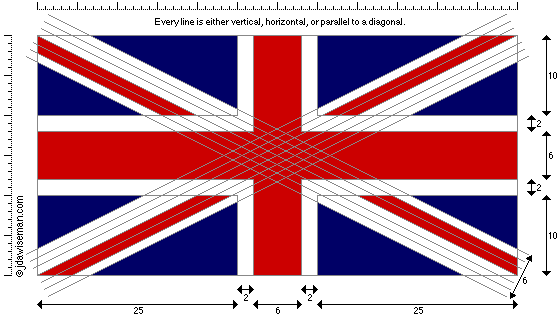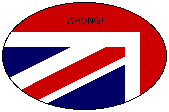.
|
Drawing The Union Jack AccuratelyJulian D. A. Wiseman Contents: |
 |
|||||
|
The flag of the United Kingdom, the Union Jack, is a superposition of the flags
of Saint George
(for England), Saint
Andrew (for Scotland) and
Saint Patrick
(for Ireland). This superposition is quite intricate, and often drawn
incorrectly. The flag is twice as wide as it is high. The cross of St George is red, and has width equal to one fifth the flag's height, and a white border of width one fifteenth the height. The cross of St Andrew is interchanged with that of St Patrick. Start by drawing the diagonals of the whole flag, and then the lines parallel to these that are at a distance of one tenth and one fifteenth the height of the flag. (For clarity the diagram also shows the lines that are apart from the diagonals by only one-thirtieth the height.) On the flag-pole side fill red the diagonally-orientated area of width one fifteenth the height that lies below the diagonals, and on the non-flag-pole side, the diagonally-orientated area of width one fifteenth the height that lies above the diagonals. Finally, fill blue everywhere that is both more than one-tenth the height away from the diagonals, and more than one fifteenth the height away from the red of the cross of St George. The blue should be Pantone 280, approximated here with an RGB setting of 0:0:102, and the red should be Pantone 186, approximated here with 204:0:0. (Thanks for drawing my attention to the colours goes to Graham Bartram, who maintains a site with excellent images of UK flags at www.flags.net/UNKG.htm.)
Areas. If the flag is drawn 60 by 30 as in the top diagram, then the various parts have areas as follows, where s is the positive square root of five. The red of the cross of St George is of area 504 square units. The blue of the cross of St Andrew is in eight pieces, four larger and four smaller. The larger pieces each have area (335-75s)/2; the smaller each 445/4-30s; giving a total blue area of 1115-270s, which, at about 511.261646 square units, is slightly more than 1.44% larger than the cross of St George. The red of St Patrick is in four pieces, two larger and two smaller, these respectively each having area 20s and 20s-5; for a total of 80s-10, about 168.8854382 square units. Thus the flag is red : white : blue in the proportions 494+80s : 191+190s : 1115-270s, or about 37.38% : 34.21% : 28.4%. The author is occasionally asked which of "Union Jack" and "Union Flag" is the correct name. The Flag Institute answers as follows:
However, the Royal Navy disagrees:
The author enquired of the Royal Navy about this apparent disagreement, asking which of the Flag Institute and the Royal Navy is right? The Naval Historic Branch directly, of 3-5 Great Scotland Yard London SW1A 2HW, answered as follows:
Learned comment on the Union Jack and its many variants can be found at flagspot.net/flags/gb.html, which in turn links to some specifications at flagspot.net/flags/gb-templ.html. Further information on its history and use can be found at the official website of the British Monarchy. Also available on this site is a PostScript version of the Union Jack. Julian D. A. Wiseman, November 1999 The specification of the geometry of the US flag, though not of the colours, can be found at www.usflag.org (and there is a local copy at www.jdawiseman.com), and that of the Australian flag at www.itsanhonour.gov.au/pdf/flag_template.pdf (local copy).
This page was last updated on
Tuesday, 24 June 2003.
Please note: This page is designed to work with Internet Explorer, some pages WILL NOT work
correctly with other browsers, sorry but it was a decision based upon available time. If
you wish to download IE click here.
|
||||||

